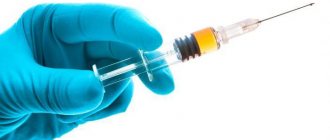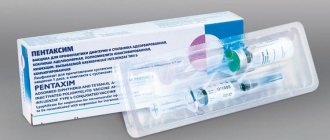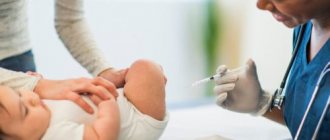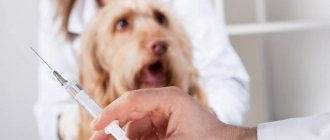Why is vaccination necessary?
Vaccination or active immunization is a widely used method in the world for the mass prevention of infectious diseases, both viral (measles, rubella, mumps, polio, hepatitis B, etc.) and bacterial (tuberculosis, diphtheria, whooping cough, tetanus, etc.).
It does not cure the disease, but prevents its development. The meaning of vaccination is that vaccines are introduced into the human body - preparations that contain weakened or killed pathogens of various infections or their individual parts (antigens) that can cause an immune response.
Our immune system reacts to a vaccine as if it were an infection, producing antibodies that will protect us in the future. However, the vaccine itself cannot cause the disease. Important! Vaccination is the safest and most effective way to prevent most infectious diseases.
Immunity
The immune system protects the body from infectious and non-infectious foreign agents. When cells that differ genetically appear and accumulate in the body, a cascade of immune reactions is triggered and an immune response is formed. The main purpose of the immune system is to neutralize a potentially dangerous antigen and develop resistance to it. Structure
The immune system consists of a collection of lymphoid organs and tissues, the total mass of which is 2% of the body weight and which are separated from each other in an anatomical sense. However, due to the presence of mediators, signaling molecules and cells capable of migration to various organs and tissues, the immune system represents a clearly organized structure in a functional sense.
The immune system includes central and peripheral organs. The central ones include the thymus and bone marrow. In these organs, the maturation of mature lymphocytes begins. Peripheral organs include the spleen, lymph nodes and lymphoid tissue, liver, blood, and lymph. The most well-known structures are the tonsils and Peyer's patches.
Lymphocytes are the main functional cells of the immune system. They are formed in the bone marrow and then undergo maturation. Depending on the organ in which lymphocytes undergo maturation, they are divided into two heterogeneous populations: T-lymphocytes (thymus) and B-lymphocytes (lymph nodes). T lymphocytes are responsible for cellular immunity, B lymphocytes are responsible for humoral immunity. B lymphocytes are the precursors of antibody-forming cells.
Principles of interaction
Immune reactions are based on mechanisms for recognizing and destroying foreign agents coming from outside or formed inside the body. The mechanisms are represented by specific and nonspecific protection factors. The first to be included are the links of nonspecific protection, which include:
- mechanical barriers (skin, ciliated epithelium and mucus of the respiratory system, etc.);
- physicochemical barriers (pH, digestive enzymes);
- immunobiological barriers: complement system, interferon, phagocytic-active cells, natural killer cells, etc.
Specific protection factors are included as a second line of defense.
They combine the reactions of antibody formation, immune phagocytosis, immediate and delayed hypersensitivity, reactions of immunological tolerance and memory. Due to the existence of the “immunological memory” mechanism, the immune response upon repeated interaction with the same antigens occurs in a shorter time and is more pronounced. Induction of immunity is a favorable outcome of immune reactions and leads to the restoration of homeostasis in the body.
Types of immunity
The state of immunity is ensured by inherited and individually formed mechanisms.
The first refers to the immunity of humans or certain animal species to the causative agents of certain infectious diseases. For example, people are immune to the causative agent of canine distemper, many animals are immune to the measles virus, gonococcus, etc. Resistance to the corresponding infection is inherited as a species trait and manifests itself in all representatives of a given species. This is innate immunity or species immunity.
Acquired immunity develops throughout an individual's life. An example of natural acquired immunity is immunity to infection after an illness. The so-called post-infectious immunity. For example, chicken pox.
Acquired immunity can be active or passive. Actively acquired immunity occurs as a result of an infectious disease or the introduction of a vaccine into the body. Passively acquired immunity is formed by the transfer of antibodies from mother to fetus or can be artificially created by parenteral administration of ready-made immunoreagents into the body. These include specific immunoglobulins, immune sera and lymphocytes that can protect the body from antigens.
Immunity can be generalized and local. With local immunity, the body’s integuments that come into contact with the external environment are protected: the mucous membranes of the genitourinary organs, gastrointestinal tract, etc.
There are several types of immunity depending on the properties of antigens:
- antibacterial;
- antiviral;
- antitumor;
- transplant immunity;
- antiparasitic;
- antitoxic, etc.
An immune reaction against self-antigens is called autoimmune.
Each of the immunities has its own characteristics of the course. Immune status
The characteristics of the state of the body's immune system, expressed by quantitative and qualitative indicators of its components, are called immune status. Determination of immune status is carried out with the aim of correctly diagnosing the disease, predicting its course and choosing a treatment method.
Are vaccines and vaccinations the same thing?
Vaccination by definition is the process of administering a vaccine; this term comes from the verb “to inoculate” and is synonymous with vaccination. Vaccinations are given according to a specific schedule, they are noted in the medical record or vaccination certificate. Everyone should follow the vaccination schedule, especially for people who live in close groups. In kindergartens, schools or the army, conditions are perfect for the spread of many serious infections transmitted by airborne droplets or through food and utensils.
Important! When vaccinating against the same disease, different vaccines may be used; for example, children's vaccines are not always suitable for adults. Often one vaccine protects against several diseases at once (like the DTP vaccine against whooping cough, diphtheria and tetanus). This helps reduce the number of injections and trips to the doctor.
Vaccine mission
Vaccines play an unnoticed but very important role in our lives. Here are their main functions:
- Prevention of infection. Vaccinations reduce the risk of contracting dangerous infections by building acquired immunity. The immune system “remembers” the antigens of pathogens that are administered along with the vaccine. Later, upon contact with the same pathogens, it recognizes and destroys them.
- Prevention of complications. Although rare, even after the introduction of a vaccine you can become infected with a wild infection and get sick. The advantage is that in this case the disease is much more likely to be mild, and the risk of severe complications and death for vaccinated patients is several times less than for those who have not been vaccinated. For example, immunization against tuberculosis reduces the risk of developing meningitis and the generalized form of this infection by 5 times.
- Protection against incurable diseases. For some infections there is no specific treatment. Rabies, which can be contracted after being bitten or salivated by a sick animal, has a 100% fatality rate. About 99% of cases of transmission of the rabies virus from animals to humans involve bites from domestic dogs. The only way to fight this disease is a vaccine. If you are bitten, you need to get vaccinated as soon as possible, before the first characteristic symptoms (excitability, fear of hydrophobia) appear. Another example of an incurable disease is the human papillomavirus, which is the most common cause of cervical cancer. You cannot get rid of it, but you can prevent infection by getting vaccinated on time. Because the virus is transmitted sexually, the vaccine should be received before sexual activity begins.
- Formation of collective immunity. When the majority (at least 70%) of the population is vaccinated, the infection stops spreading and there are no new cases of infection. At the same time, vaccinated people protect unvaccinated people, making up their immediate environment (Fig. 1). Having herd immunity is very important for those who cannot receive the vaccine due to contraindications. If vaccination is widespread enough (some diseases are incredibly contagious and very difficult to stop), the infection can disappear completely. This happened with smallpox, the last case of infection of which was recorded in 1979. Another example is polio. It has not yet been completely defeated, but there are very few dangerous regions on the planet where it can be infected. Today these are Afghanistan, Pakistan and Nigeria.
A.
B.
IN.
Figure 1. Illustration of how herd immunity works. A - there are no vaccinated people in society, the outbreak of infection affects almost everyone. B - a large percentage of those vaccinated protects some of the people who did not receive the vaccine. B - there are not enough vaccinated people in society; the disease affects almost all susceptible people. Source
Help your immune system. Why does the body need interferon after vaccination?
During the period of vaccination against COVID-19, many people have different questions: “How will my body tolerate the vaccine? Is there a risk of getting ARVI? How to protect yourself from coronavirus between doses of the two components of the vaccine? We talked about drugs that help not only fight the virus, but also strengthen the immune system, with Alexander Karaulov , Doctor of Medical Sciences, Academician of the Russian Academy of Sciences, Head of the Department of Clinical Immunology and Allergology, Head of the Laboratory of Immunopathology of the First Moscow State Medical University. I. M. Sechenov.”
— Alexander Viktorovich, how does the body react to the introduction of the vaccine?
- In fact, with the help of a vaccine, we train our immune system for a future meeting with the pathogen. Scientists emphasize that approximately 3% of the population suffers from COVID-19 severely, and 0.3% may have a life-threatening course of the disease. Moreover, if earlier we saw that severe cases were more common among the elderly and patients with concomitant diseases, now the majority of life-threatening conditions occur in patients aged 40 to 60 years. Only 50% of those who have had COVID-19 have developed antibodies.
Vaccination protects against infection, and if it does occur, the infection is mild. However, post-vaccination immunity is formed differently in different groups of people. Its formation can be slowed down in older people or patients with weak immunity, that is, in those whose body’s defenses are weakened by past or concomitant infections, chronic diseases, stress, malnutrition, environmental conditions, etc.
Photo: Shutterstock.com
— Nowadays there is a lot of talk about interferons, that they strengthen the immune system. Many studies have already been published on the use of drugs of this group for COVID-19; in Russia they have become part of the standards of medical care. How do interferons work during vaccination?
— Interferons in our body perform a regulatory function. To put it figuratively, interferon is a traffic controller at a crossroads: it directs the immune response in the right direction, thus promoting recovery. This property of interferon is also excellent for preparing for vaccination, which, in essence, is also the body’s immune reaction, but not for the purpose of recovery, but for the purpose of more effectively producing antibodies against the causative agent of the disease.
— How exactly does interferon affect the level of antibody production?
— Interferons promote the activation of the immune system, enhance the production and maturation of cells that trigger the formation of a high-quality immune response. Interferon-based drugs can be used before vaccination, several hours later, or the next day after the vaccine is administered. You just need to understand that they do not act instantly: this is a process that will take some time. Taking into account the accumulated clinical experience, I would recommend, for example, a rectal form of interferon for five days before vaccination or five days after. This can enhance the formation of an immune response and prevent the patient from contracting other diseases while an adequate level of antibodies to the vaccine has not yet been developed.
— Is it possible to get sick with ARVI or the same “corona” during vaccination?
— You can get sick because at this moment all the energy of the body is directed, as I said earlier, to the production of antibodies: immunity is not formed from the first day, this has already been voiced many times. Of course, there is a risk of getting another or the same infection for which you are vaccinated if antibodies have not yet developed. To prevent this from happening, prevention is needed. Unfortunately, people are so tired of the pandemic that, after getting their first vaccination, they often stop even wearing masks. But it is important to understand that any disease during the vaccination period is a double burden on the body. Therefore, you need to behave very responsibly during this period.
After vaccination, you also need to wear masks, continue to wash your hands regularly, and use preventive measures, such as interferon gel.
— In what cases, in addition to vaccination, can interferon drugs be used during the COVID-19 epidemic?
— First of all, as a preventative measure, use gel or ointment with interferon, which are applied to the nasal mucosa. In fact, this is a universal means of preventing ARVI, the effectiveness of which was proven even before the coronavirus pandemic, during the annual flu epidemics. Gel bases have a prolonged (long-lasting) preventive effect and are convenient to apply.
— Is it possible to treat COVID-19 with interferon drugs?
— As for treatment, I cannot help but draw attention to the importance of using the rectal form of interferon: suppositories. In this case, the body, weakened by the disease, receives the missing interferon necessary for an adequate response to the infection, additionally in the drug. Suppositories have a systemic effect on the body as a whole, that is, interferon administered rectally can penetrate all organs and tissues affected by the virus. Today we are faced with a huge number of neurodegenerative complications of COVID-19. The virus easily penetrates the organs of the central nervous system, sometimes causing irreversible changes in them. Thanks to rectal administration, interferon, using the lymphatic pathways, is able to penetrate into the cerebrospinal fluid, preventing the development of dangerous complications. It is also quickly delivered to the lungs - it is not without reason that it has been used for many years in the treatment of pneumonia.
Research on the use of interferon for coronavirus is actively underway in the West and in Russia. We receive new data almost monthly. For example, our colleagues from Omsk Medical University conducted a study involving 140 patients with COVID-19. 70 of them received standard therapy, and another 70 combined it with VIFERON rectal suppositories and gel, both of which were used regularly for 14 days. According to the results of the study, the symptoms of intoxication in such patients - headache, muscle pain, weakness - stopped 2-8 days earlier. The cough disappeared by the 5th day from the start of treatment, a runny nose was recorded only for 3 days, patients stopped noticing disturbances in taste and smell by the fourth day from the start of treatment, shortness of breath stopped by the third day. In patients who did not receive additional interferon, all symptoms of the disease lasted statistically longer.
I note that in the initial stages of the disease the rule “the sooner, the better” really works. Early initiation of interferon therapy reduces the mortality rate and demonstrates better treatment results. This was confirmed by studies of our Chinese colleagues, who showed that if the initial level of interferon alpha increases, for example, due to therapy, then, as a rule, we will have a favorable outcome of the disease.
How does the immune system work?
Immunity protects the internal environment of the body from everything foreign, primarily from pathogens of infectious diseases. The immune system is usually divided into two parts:
- Innate immunity. This is the defense system that protects us from diseases from birth. This includes anatomical and chemical barriers (skin, mucous membranes and natural antimicrobial compounds covering them), the complement system (protective blood proteins) and many immune blood cells (macrophages - “eaters” of microbes, dendritic cells, granulocytes, mast cells).
- Acquired immunity. This part of the immune system is responsible for the specific immune response that is produced throughout life when our body encounters new microbes. The main fighters of acquired immunity are T lymphocytes (attack foreign cells or help activate other immune cells) and B lymphocytes (produce protective antibodies). After activation, some of them become memory cells, thanks to which our body remembers the infection for a long time and reacts to it much faster when it is re-infected.
Both of these types of immunity are closely related, and many features of their work are still being actively studied.
How is immunity to coronavirus formed?
It has already been proven that COVID-19 affects the functioning of all body systems and has long-term consequences. In order to minimize the risk of infection, immunity is necessary. It forms after recovery from coronavirus (natural immunity) or after vaccination (artificial immunity).
Natural immunity occurs after the virus itself enters the body.
The defense system recognizes it as an “enemy” and causes T- and B-lymphocytes to multiply. B cells produce antibodies: IgM, IgA and IgG, some of which will die in the fight against the virus. Others will remain circulating in the blood and protecting the body from further infection. IgG plays the main role. They remain in the body for a long time and protect the body from repeated attacks of the virus.
Over time, the level of IgG antibodies drops, and the immune system “forgets” the virus. Doctors are already identifying repeated cases of coronavirus infection and giving a prognosis: antibodies in the body last up to six months on average.
Artificial immunity occurs after the introduction of a vaccine into the body that carries not the virus itself, but its “trace”
For example, Russia's Sputnik V contains part of the RNA that codes for the COVID-19 spike S protein. It is delivered into cells using a vector (a weakened adenovirus). This “carrier” is absolutely harmless.
The Sputnik V vaccine is administered twice. The first injection is carried out with that part of the vaccine that is based on adenovirus type 26. It delivers the gene encoding the S-protein into the cell, after which the body begins to produce immune cells, but so far in small quantities. After 21 days, the second part of the vaccine is administered. It is based on another, not yet familiar to the body, adenoviral vector - type 5. It enhances the production of antibodies and provides long-term immunity. As after the disease, coronavirus-specific IgG begins to circulate in the blood of vaccinated people.
How does a vaccine create acquired immunity?
When you first become infected with an infection, the immune system takes some time to develop acquired immunity. It works more efficiently than the innate one and can protect us throughout our entire lives, but such immunity is not formed immediately.
The same principle applies to vaccination. Simply put, the development of acquired immunity occurs in four stages:
- Induction. Macrophages attack foreign cells and transmit information about the antigen to lymphocytes.
- Immunoregulatory stage. T and B lymphocytes are targeted to fight the infectious agent.
- Effector stage. Specific antibodies and T-lymphocytes are produced against the infection.
- Formation of immunological memory, which allows you to instantly respond to the invasion of the pathogen against which you were vaccinated.
It takes about a month to develop protection, so vaccination against influenza or tick-borne encephalitis is done in advance.
To help the immune system

Specific and nonspecific immunity
Immunity can be innate or acquired. Innate immunity is called nonspecific. It is provided by the innate biological characteristics of the body. As is known, different people have different resistance to the same disease. Often it is congenital immunity to any infectious diseases that we mean by the word “immunity”.
Acquired immunity (specific) is the body’s immunity to certain infectious diseases. Acquired immunity to a particular disease, as its name suggests, can occur throughout life. Acquired immunity is not inherited.
There are active and passive acquired immunity. Active immunity appears after a previous illness or active immunization (as a result of vaccination or vaccination: the introduction of weakened viruses or bacteria). After encountering a pathogen, the body itself begins to recognize it and independently produces antibodies, which are the main weapon to fight the infection.
Passive immunity provides ready-made antibodies artificially introduced into the body. For example, passive immunity occurs when anti-diphtheria serum is administered or when antibodies enter the child’s body through mother’s milk.
Active immunity is more stable, longer lasting and specific (that is, it protects only against a specific pathogen). In some diseases (for example, measles, scarlet fever, etc.) it persists for many years, in others (for example, smallpox) it lasts a lifetime. How is immune defense “organized” in our body?
The first barrier for most microbes is intact skin and mucous membranes, since they, in addition to mechanical protection, have bactericidal properties. The protective properties of the skin are due to the secretions of the sweat and sebaceous glands. For example, typhoid fever pathogens die after 15 minutes of contact with healthy human skin. The mucous membranes secrete secretions that are even more destructive to microbes.
But with a massive attack of microbes or with their high pathogenicity (the ability to cause disease), skin and mucous barriers are not enough, and the microbes penetrate the body. In this case, inflammation occurs, complex mechanisms of cellular and humoral immunity are activated: leukocytes and other cells of the body begin to work, phagocytes capture and digest the antigen, special substances begin to be produced that are aimed at combating foreign microorganisms, such as interferon, immunoglobulins and others. All these body reactions are manifestations of nonspecific immunity.
Simultaneously with nonspecific immunity, specific immunity is activated. It causes the formation of antibodies in the body - protective factors directed specifically against a specific microbe. But the speed and efficiency of antibody production depend on whether the body has previously encountered the causative agent of a given disease or not. If the body “recognizes” the pathogen (that is, it has already suffered a disease or vaccination before), then the infection is suppressed quickly. If a collision with such a microorganism occurs for the first time, then the production of antibodies requires time for the body to learn to fight the new microbe. When does immunity decrease?
The human immune system is weakened by: improper and inadequate nutrition, including insufficient supply of vitamins and essential minerals; overwork and chronic stress; taking antibiotics and hormonal drugs; atmospheric pollution, unfavorable radiation conditions.
In addition, immunity decreases during surgery and anesthesia, with injuries, burns, hypothermia, blood loss, infections and intoxications, frequent colds, chronic diseases, including diabetes. A decrease in immunity primarily manifests itself in infectious and especially colds, such as acute respiratory viral infections and influenza.
It is worth mentioning separately about children's immunity. During the period of child growth, critical conditions of decreased immunity occur. There are five such periods: the neonatal period (the first 29 days of life); from the 3rd to the 6th months of life; 2nd year of life; from 4th to 6th years of life; teenage years.
Decreased immunity in children is reflected in an increase in the number of diseases. Therefore, in pediatrics, a special term “frequently ill children” (FCH) has even been introduced. This category includes children who get sick 4 times a year or more often or for more than 2 weeks in a row. How to strengthen your immune system?
You can strengthen the body’s ability to resist various diseases by influencing both nonspecific and specific immunity. Strengthening nonspecific immunity is an increase in the overall resistance of the body. As a rule, the words “strengthen the immune system” mean the normalization of nonspecific immunity.
To strengthen the immune system, you should: follow a daily routine; eat nutritiously, make sure that the diet contains a sufficient amount of vitamins, minerals and amino acids of animal origin; exercise, exercise, or at least exercise regularly; take antioxidants and other drugs designed to strengthen the immune system (for example, based on beta-carotene); Avoid taking antibiotics unless recommended by your doctor.
There is only one way to strengthen or, rather, create specific immunity against a certain disease - vaccination. However, it should be borne in mind that with active vaccination (that is, with the introduction of a weakened pathogen), the body’s defenses are aimed at producing antibodies, as a result of which resistance to other diseases is somewhat reduced. Therefore, before and after vaccination it is necessary to strengthen nonspecific immunity. How to vaccinate correctly?
Vaccination is a reliable way to protect yourself from a specific disease. When vaccinated, active immunity is formed by introducing a weakened or killed (inactivated) virus, which itself cannot cause disease in a healthy person, but “turns on” the functioning of the immune system.
It is important to remember that any vaccination somewhat weakens general immunity in order to increase specific immunity. As a result, side effects may occur, for example, the appearance of mild “flu-like” symptoms (malaise, headache, slightly elevated temperature). In children, the main problem is the development of various infections or exacerbation of underlying diseases after vaccination. According to the Research Institute of Children's Infections, complications of the post-vaccination period most often develop in children: those included in the category of frequently ill people (37.8%); with allergic reactions (20.9%); with lesions of the central nervous system.
In healthy children, the probability of developing side effects after vaccination does not exceed 2.1%. To avoid unwanted reactions to the introduction of a vaccine, it is necessary to prepare the body for vaccination in advance, that is, to normalize the functioning of the immune system. Taking beta-carotene preparations, such as Vetorona, has a good effect.
Beta-carotene-based medications should be started 1 month before vaccination and continued for 1 month after vaccination. This should be done both with a regular flu shot and with routine vaccinations.
How does beta carotene affect the immune system?
Beta-carotene has a multifaceted effect on the immune system, acting as: a source of vitamin A; immune stimulant; antioxidant.
Beta-carotene is a source of vitamin A.
Beta-carotene is converted into vitamin A in our body, which plays an important role in the functioning of the immune system. Vitamin A is involved in antitumor and antiviral protection, provides resistance to autoimmune and immunodeficiency conditions. Vitamin A is also responsible for the formation of protective cells that line the respiratory tract and gastrointestinal tract and serve as a natural barrier to infection. According to many scientists, vitamin A plays a major role in the formation of immunity.
Beta-carotene is an immune stimulant.
Beta-carotene manifests itself as a “true” immunomodulator, that is, it increases the body’s potential regardless of the type of pathogen. Beta-carotene is involved in the synthesis of the protective protein interferon, which is produced by cells of the immune system and actively prevents the proliferation of viruses. This allows you to improve the body's antiviral defense.
The production of interferon decreases with a long course of the disease (for example, in frequently ill children), but beta-carotene can stimulate additional synthesis of this substance and thereby strengthen the body's immune system.
Beta-carotene is an antioxidant.
Beta-carotene neutralizes free radicals and has high antioxidant activity. Beta-carotene also restores vitamin E, which loses its antioxidant properties when fighting free radicals. Thus, beta-carotene affects the immune system both directly and indirectly through vitamin E.
article from the site https://med-info.ru/
What's hidden in the syringe?
All vaccines can be divided into two groups:
- Corpuscular vaccines. They contain a weakened live (vaccines against polio, measles, mumps, rubella, tuberculosis) or a whole “killed” (vaccines against whooping cough, rabies, viral hepatitis A and polio) microorganism (Fig. 2 A and B). Infectious pathogens are weakened by growing them in the laboratory in cell cultures until the wild strain changes its properties, becoming safe enough to promote the formation of immunity, but not cause the disease itself. Formaldehyde is most often used to “kill” viral or bacterial cells. Such vaccines are safer than live ones, but the immunity after them is less durable.
- Subunit vaccines. The composition of such preparations does not include whole microorganisms, but only individual components of the cell wall or other parts of the pathogen (vaccines against whooping cough, meningococcal infection, etc.) (Fig. 2 B). This group also includes vaccines containing inactivated bacterial toxins (diphtheria and tetanus vaccines) and recombinant vaccines. The latter are obtained using genetic engineering methods, when the genetic material of a dangerous microorganism is placed in yeast, after which the modified yeast produces the antigen proteins necessary for the vaccine. Examples include vaccines against hepatitis B virus and human papillomavirus.
A.
B.
IN.
Figure 2. How different types of vaccines are obtained. A - Corpuscular live weakened (attenuated) vaccines. B — Corpuscular “killed” (inactivated) vaccines. B - Subunit vaccines. Source
Important! At the same time, science does not stand still, inventing new approaches to obtaining vaccines. For example, DNA vaccines are among the new generation of drugs. In this case, the vaccine is not a protein that is characteristic of a pathogenic microorganism, but a piece of its DNA or RNA inserted into a safe virus or into a plasmid (a ring of DNA). After this DNA penetrates into the cells of the body, they begin to produce the necessary antigen protein, to which our immune system reacts. So far, DNA vaccination is a very young, but promising direction. Experts believe that with its help you can effectively fight cancer and many dangerous infections, such as HIV and hepatitis C.
In addition to the main active ingredient (bacteria, viruses or parts thereof), vaccines may contain various preservatives, adjuvants (substances that enhance the effectiveness of the vaccine), antibiotics and stabilizers.
Vaccination methods
Each vaccine has its own method of administration to ensure a quick and safe effect of the drug.
Subcutaneous and intramuscular injections
Corpuscular vaccines are often administered as an injection (shot) intramuscularly, under the skin of the thigh, shoulder, or shoulder blade. The rate of development of immunity is average. Redness or swelling may appear at the injection site, which usually goes away quickly.
There are fewer adverse reactions after injection of the vaccine into the muscle, and immunity is developed faster and is stronger.
Oral
An oral live vaccine against polio and some intestinal infections is dripped onto the tongue. It's simple, quick and painless.
Intranasal
The flu vaccine may be sprayed into the nose to provide protection against airborne infections.
Basics of the doctrine of immunity
The immunity of macroorganisms to the effects of pathogenic microorganisms and their metabolic products (toxins) is called immunity. Immunity is produced by the entire body, with the central nervous system playing a major role.
Immunity can be either congenital or acquired. Innate immunity is a specific genetic property of the body, i.e. it is inherited and is highly resistant;
for example, humans are immune to canine distemper.
Acquired immunity is not inherited. It is produced individually by each organism during its life for certain diseases and is less resistant than the innate one (it can be lost after a certain period of time). It is characterized by specificity: a person who has had diphtheria acquires only anti-diphtheria immunity. There is a distinction between naturally acquired and artificially acquired immunity. Naturally acquired immunity is immunity developed as a result of the body experiencing an infectious disease. In addition, natural immunity is transmitted from mother to child during its intrauterine development. The immunity created in this way is called placental and persists in newborns for up to six months.
A special form of natural immunity is infectious immunity. It is produced as a result of infection of the body by pathogenic microorganisms and is not lost as long as these microorganisms are present. Infectious immunity is developed during tuberculosis and various viral diseases. Unlike other forms of immunity, in which the body is completely freed from infection, this immunity does not have this ability and is called non-sterile.
Artificially acquired immunity is caused by the introduction of vaccination preparations into the body - vaccines and serums. Vaccines are weakened or killed cultures of microorganisms or their toxins. Serums are preparations containing active bodies—antibodies in animal blood. Artificially acquired immunity, in turn, is divided into active and passive. Active is produced when the body is vaccinated with live or dead vaccines, passive is produced when ready-made protective factors are introduced - antibodies taken from another immune organism. Passively acquired immunity occurs quickly (1-2 hours after administration of the serum), but does not last long (15-20 days) as long as the injected antibodies are present. The body does not take any part in creating passive immunity.
Thus, each type of immunity is the result of a long evolution of the relationship between macro- and microorganisms.
Human skin is the main barrier that protects the body from the introduction of various microorganisms. The skin has bactericidal properties;
for example, Smarcescens on healthy skin dies after 30 minutes by 100%.
The protective function of mucous barriers - the conjunctiva of the eyes, mucous membranes of the nose, mouth - is associated with the presence of lysozyme in their secretions, which has bactericidal properties.
The main mechanism of the body's protective-adaptive reaction is phagocytosis. The doctrine of phagocytosis was developed by I.I. Mechnikov. Phagocytosis is the process of absorption and digestion of microorganisms by cells of the reticuloendothelial system (liver, spleen, lymph nodes, bone marrow) and blood leukocytes. These cells are called phagocytes. Leukocytes have the greatest activity.
Humoral factors that provide immunity to infectious diseases are bactericidal substances in blood serum. The substance that causes this action is called complement. Complement is a component of blood. Complement itself has a weak bactericidal effect, but it increases the effect of specific antibodies and other antimicrobial factors. Along with complement, other antimicrobial substances were found in the blood serum - leukins and lysines. Leukines are contained in leukocytes and are released when they die, lysines are found in the serum in a free state. They have a stronger bactericidal effect against anaerobes and bacteria of the genus Staphylococcus than leukins.
In addition to humoral factors, antibodies play a huge role in creating immunity. The formation of antibodies is a response to the introduction of foreign bodies - antigens - into the body. Antigens are organic substances that, after being introduced into the body, bypassing the digestive tract, form antibodies. Antigens can be various proteins, live and dead microorganisms, their toxins, etc. Antigens have two properties: they cause the formation of antibodies in the body and enter into a specific interaction with them. Antibodies are globulins (7-globulins) modified under the influence of antigen, which are formed in the bone marrow, lymph nodes, spleen, liver, etc. The following antibodies are distinguished: antitoxins, agglutins, precipitins, bacteriolysins, hemolysins. Antitoxins are formed when the body is immunized with exotoxins and neutralize them; agglutinins glue the infectious agent together; precipitins upon contact with the antigen give a precipitate in the form of a gray-white ring; Bacterolysins dissolve bacteria, and hemolysins dissolve red blood cells (erythrocytes). All of these reactions are called immune reactions .
Why do some vaccinations need to be given more than once? Revaccination
Repeated vaccination and revaccination are done to consolidate the effect, to strengthen the immune response and extend its duration. Revaccination also helps to expand the field of action of immunity when new strains of pathogens appear (this applies, for example, to flu vaccinations).
Almost all vaccines are administered multiple times; up to 6 doses may be required to develop immunity (protection against polio, complex vaccination against diphtheria, whooping cough and tetanus). And revaccination against influenza is carried out annually.
What test can be used to check post-vaccination immunity?
This test is called “Quantitative determination of antibodies to the RBD domain of the S1 protein of the coronavirus (IgG antibodies)” (performed by chemiluminescent immunoassay of serum and plasma, Abbot).
This is a quantitative test for IgG antibodies. It will help assess the immune response both in case of infection (or previous COVID-19) and to monitor post-vaccination immunity.
When to do it:
- for a current or past infection no earlier than three weeks after the onset of symptoms or a positive PCR test result;
— to assess post-vaccination immunity three weeks after the second dose of the vaccine.
What the results say:
< 50.0 AU/mL negative:
antibodies to the pathogen are absent or at very low levels.
This may be a period of early infection or the patient may have impaired immune system function.
≥ 50.0 AU/mL positive:
there is an immune response to the infection or a post-vaccination response has formed.
What is the national vaccination schedule?
Today, almost all countries of the world have special national vaccination calendars. They provide widespread, free vaccination to protect against a number of dangerous infections.
The Russian national calendar of preventive vaccinations provides protection against 12 different infections:
- hepatitis B,
- tuberculosis,
- tetanus, whooping cough and diphtheria,
- hemophilus influenzae infection,
- polio,
- rubella, measles and mumps,
- pneumococcal infection,
- flu
It determines the timing of the introduction of vaccines, establishes the order and frequency of revaccination, and determines the age at which one or another vaccination should be given.
The list of vaccinations can be expanded for risk groups or in the event of an epidemic threat (preventive vaccination calendar for epidemic indications). Some vaccines can be given on an emergency basis, immediately after possible exposure.
Despite the fact that the bulk of vaccinations in the Calendar are intended for children and adolescents, adults should also not forget about timely immunization. Booster vaccination against diphtheria and tetanus should be done every 10 years, and against influenza every fall. If you are planning a pregnancy or planning to travel to an exotic country, you may also need additional vaccinations.
Some developed countries vaccinate on a large scale against more infections, such as rotavirus, hepatitis A, meningococcus and human papillomavirus. Based on the opinions of the world's leading experts in the field of vaccine prevention, the Union of Pediatricians of Russia has compiled its own expanded vaccination schedules for children and adolescents.
Duration of protection against coronavirus after vaccination
Despite the fact that immunoglobulins G are formed both after coronavirus and after vaccination, the formed immunity is not the same. What is important is not the time that has passed since recovery or the vaccine, but the number of antibodies to coronavirus in the blood.
Scientists have already managed to collect statistics and it turned out that immunity obtained naturally is not stable, and cases of re-infection have already been registered. In this case, the second time the disease is sometimes more severe than the first time. That is why the only way to safely obtain immunity is vaccination.
The duration of IgG circulation after vaccination varies from person to person and depends on the individual characteristics of the body. However, antibodies against coronavirus are always formed after vaccination and in greater quantities than after the disease. Officially, the Gamaleya Center announces that protection will be maintained for up to six months, but it is already becoming clear that this is only a lower time threshold.
“Today, observations show that immunity absolutely lasts six months after an illness, therefore, the vaccine should not give a shorter period” - head of Rospotrebnadzor Anna Popova
Vaccines based on the adenoviral vector have already been well studied and have been used in the world for a long time. Using this experience, we can say that antibodies after vaccination last up to two years. Moreover, there are already research results and information about the first people vaccinated with the Sputnik V vaccine. For example, it is known that the employees of the Gamaleya Center have developed a strong immunity to coronavirus, which has persisted for more than nine months.
What happens if you don't vaccinate yourself or your children?
What happened in the pre-vaccination era, when adults were seriously ill with all kinds of infections, and children died from them in the thousands. Children's cemeteries in European and American cities were then commonplace (Fig. 3).
Figure 3. Children's graves dating to the 1890s at the Central Mississippi Family Cemetery. Diphtheria was a common cause of death in children until the introduction of the diphtheria vaccine in 1921. Source: Red book. Atlas of pediatric Infectious diseases. Editor: Carol J. Baker, MD, FAAP. American Academy of Pediatrics. -2020
The epidemics of measles, diphtheria and polio, which broke out repeatedly after the collapse of the USSR due to the fact that the system of compulsory free vaccination in the post-Soviet space was destroyed, best answer this question.
Another consequence is a decrease in herd immunity, which limits the spread of infection only as long as the majority of the population (70–80%) is vaccinated against it.
Immunization in Russia is voluntary. This means that parents have the right to independently decide whether they will vaccinate their child. Schools and kindergartens in our country can only temporarily deny attendance to an unvaccinated child if there is a threat of an outbreak of infection or during an epidemic (FZ-157 “On the immunoprevention of infectious diseases”). Rospotrebnadzor also recommends separating children who have not been vaccinated against polio from those who have received oral live polio vaccine for a period of at least 60 days (SP 3.1.2951-11 “Prevention of Poliomyelitis”).
Some countries refuse entry to adults and children without vaccinations. Adults may be denied employment at an enterprise that requires a medical examination.
How safe are vaccines?
The World Health Organization calls vaccination the safest and most effective way to prevent dangerous infections. Since live attenuated vaccines are very rare, but still cause severe complications and can even cause symptoms of the disease (like oral live polio vaccine), they are gradually abandoned in favor of more modern drugs containing only the antigenic components of pathogens. They are much easier to tolerate, and their use is not associated with serious side effects.
Adverse reactions when administering vaccines (redness at the injection site, fever, slight deterioration in health) are not dangerous, pass quickly and do not require treatment.
One of the most common post-vaccination complications (which themselves are extremely rare) is allergic reactions. If you are prone to them, your doctor will recommend taking antihistamines a few days before and after the vaccination. The number of other complications requiring treatment does not exceed 1%, and the proportion of serious cases even in this percentage is small.
The following vaccines have relatively high reactogenicity compared to other vaccines:
- Live attenuated measles vaccine (often given with rubella and mumps medications). After the measles vaccine, convulsions (probability - 0.025-0.3%), allergic reactions (probability - 0.0001-0.00035%), thrombocytopenia (probability - 0.0026%) may occur.
- Killed whole cell vaccine against whooping cough (administered together with diphtheria and tetanus toxoids). After the whole-cell pertussis vaccine, febrile convulsions may occur (probability - 0.022%), hypotensive-hyporesponsive syndrome may develop (probability - 0.067%), and children's crying may continue for several hours (probability - 0.4%).
Often complications after vaccines are associated with individual health conditions, such as chronic diseases or weakened immunity. You can reduce their risk by getting a blood test and being examined by a doctor before vaccination.
Contraindications
Vaccinations should not be given if the patient:
- serious allergic reactions to previous administrations of this vaccine have been observed,
- are allergic to vaccine components (for example, chicken egg white),
- the patient is in the acute phase of the disease,
- there are serious chronic diseases, the immune system is depressed.
Pregnancy is often the reason to refuse vaccination. Details about all contraindications can be found in the instructions for use for each drug separately. Before getting vaccinated, consult your doctor.
Why are antibody tests taken?
Tests are performed for the presence of antibodies (immunoglobulins) IgA, IgM and IgG.
- IgA antibodies are the first to be produced by our immune system in response to a virus invasion - if the test for them is positive, it means that the person is in the acute phase of the disease (even if he has no symptoms).
- IgM antibodies begin to be produced later, somewhere on the 3-4th day after the onset of symptoms - this type of antibody is also a marker of primary infection. Typically, testing for IgM antibodies is used as an auxiliary test to clarify the phase of the infectious process.
- IgG antibodies begin to be produced approximately 10-14 days after the onset of symptoms. Their appearance indicates that a person has developed long-term immunity. That is, we are talking either about the late phase of the disease, when the patient is already recovering, or about the fact that the person had COVID-19 earlier.
The most famous myths about vaccinations
There have always been a lot of rumors surrounding the safety of vaccines, and some of them have given rise to very persistent myths, despite the fact that there is no evidence of their veracity. Interestingly, many people take myths about the dangers of vaccines more seriously than the real threat posed by infections. We have already forgotten why measles, whooping cough and polio are terrible. It seems to us that these diseases will not return, and therefore we begin to fear vaccinations more than diseases.
Do vaccines really cause autism?
This is a common myth. In 1998, the Lancet published a paper on the link between the measles, rubella and mumps vaccine and autism. Later, the data given in it was found unreliable: some of it was falsified by the author of the article, Andrew Wakefield. In 2010, he was stripped of his medical license for violating professional ethics.
Is it true that a vaccine can chip a person?
Chipping (introducing an electronic chip) into people using vaccinations is technically impossible. Often there are several doses of the drug in one bottle. Even if it contains microchips, it is impossible to dose them by drawing the solution with a syringe from the bottle. If the ampoule contains one dose of the vaccine, the chip administered with the drug must be smaller than the diameter of the injection needle. But in this case, it may remain on the walls of the bottle with traces of liquid, which means there is no guarantee that chipping will occur. The production of vaccines is carried out under very strict control, and the entry of any foreign components into the drug is excluded.











